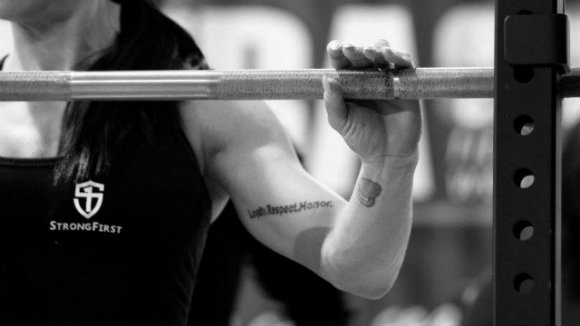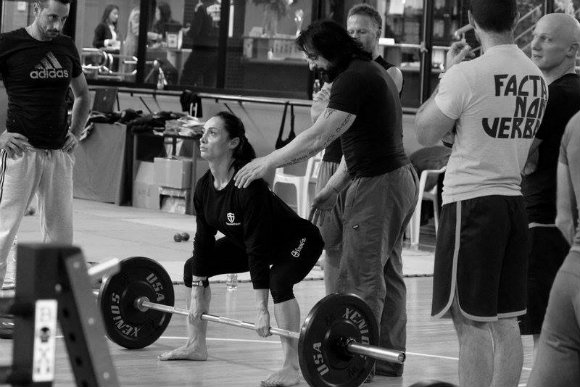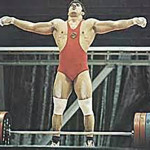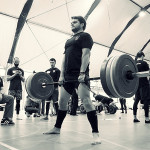300 seconds = 5 minutes. Why is this number and the resultant math to convert it to minutes important? This length of time, to those of you familiar with training with kettlebells and other metcon training methods, will seem like an eternity when told that is how long you should rest between sets when training for strength.
But according to a 2009 study on rest intervals and strength training:
[R]esting 3-5 minutes between sets produced greater increases in absolute strength, due to higher intensities and volumes of training. Similarly, higher levels of muscular power were demonstrated over multiple sets with 3 or 5 minutes versus 1 minute of rest between sets. Conversely, some experiments have demonstrated that when testing maximal strength, 1-minute rest intervals might be sufficient between repeated attempts; however, from a psychological and physiological standpoint, the inclusion of 3- to 5-minute rest intervals might be safer and more reliable.1
My observations of and experimentation with hundreds of athletes and clients in addition to my own powerlifting training over the years support the above findings.

Why Use 300 Seconds?
As a powerlifter, resting for five minutes between my work sets was easy. Rack the bar, load the weight for the next set and/or check the collars for tightness, sit down, wipe my forehead, grab a sip of water, and set the timer for five minutes.
The first two or three minutes were usually reserved for slowing down my breathing, talking shop with others around me, and just chilling. The last two minutes before moving into my next set were reserved for my mental state – making sure I was ready. You see, my goal when performing those work sets was not only to have quality reps, but also to achieve the quantity I had planned for that training session.
For example, if my training plan called for 4 sets of 5 reps at 82.5% 1RM, then my goal was to get all 20 reps. Good quality – maintaining good form and technique throughout all the reps and never sacrificing my body – was a must. But so were the 20 reps.
What helped me accomplish this were those 5 minutes – 300 seconds – between sets. This allowed most of the physiological changes that occurred during the previous set to return to normal. If I needed an extra minute or two, I took it. Again, my goal was 20 quality reps. All of them. As a result, these work sets alone might take me 20-25 minutes to complete.
Knowing this time requirement for the training session, I made sure I had enough time scheduled to complete the work sets as well as the rest of the session. Plan for it ahead of time. That way you don’t rush through your training and potentially make costly mistakes with your body.

Rest Intervals for Barbell Newcomers
During the SFL Barbell Instructor Certification, we spend four hours on the programming lecture. During part of the lecture, I discuss the 300-second period. Most of the students at the SFL Cert come from a background of kettlebells, metcons, and strength endurance where rest periods of ten to thirty seconds are normal. The SFL and the training required to pass the associated strength and technique tests usually mark the first time they have seriously trained with the barbell.
These students quickly realize that ten to thirty seconds of rest won’t cut it when training for strength and expecting results. So when I mention that it is best to take three to five minutes between sets to almost or completely recover and therefore make the most of the succeeding set, I get looks like I just told them I was from outer space.
For some trainees, this time length seems like an eternity. They ask, “What am I going to do during that time?” or “Can I do some mobility exercises?” or “Starbucks, anyone?”
While all good questions, any question regarding what to do during the rest period should receive the same answer: rest. And rest some more. Maybe go fill up your water bottle. You shouldn’t have to worry about a bathroom road trip as that should have been done prior to the work sets starting. In addition, unless you are using your cell phone calculator to add up the weights on the bar, turn off your cell and don’t use it, look at it, or even touch it during your training session.
Your mission, should you choose to accept it, is to complete all the reps of your work sets with quality – down to the last rep of the last set. As we say in our gym, “Last rep, best rep!”
Dos and Don’ts of Your 300 Seconds
Do:
- Rest 180-300 seconds (3-5 minutes) between work sets when training for strength, regardless of the implement. I lean more toward the 300-second time span.
- Plan for a potentially longer training session in your personal schedule so you don’t have to rush through and get sloppy.
- Use a timer for your rest period. My OCD personality likes to know how much time is left. Plus, it keeps you on schedule.
- Tell your training buddies to leave you alone when it gets closer to your work set, i.e. the last 2 minutes of rest. This is your time to get in the zone and get mentally ready to properly attack the next set.
- Make sure you have good posture and your extremities are relaxed when sitting in your chair during the rest period.
- Make sure you have good spotters to help you during these work sets if needed and if the movement allows them – especially during the later work sets.
- These rest periods also apply to training with kettlebells, e.g. kettlebell military press, strongman work, etc.
Don’t:
- Don’t do the next set after 1:36 of rest because you feel ready. Trust me, take the 3-5 minutes. If your training plan calls for more than one work set, use the entire length of rest time.
- Don’t perform any calisthenics, weird 70s disco moves, mobility exercises, or any other movements except walking and loading the bar for the next set. Rest!
- DON’T USE YOUR CELL PHONE DURING THE REST PERIOD.
- Don’t give up on this longer rest period when training for strength. You will get used to it and appreciate it, especially when you see the results.
Be patient my barbell student! And have a strong day!





Such a wonderful article! Works great for me for I am newly introduced to barbell deadlifts. Thank you so much.
This is a great article and solid advice. I practiced this a little doing the Starting Strength Program by Mark Rippetoe. I am now preparing exclusively for the SFG Level 1 certification in Seattle, WA in April 2016. After that I would like to become SFL certified so I have the same question as Brian – Are there any plans to have an SFL certification in the States some time in the Summer or Fall of 2016?
Doc,
Tremendous article. Any plans for SFL Stateside this year? I only see one in Dallas. Thoughts?
Thanks – great article.
I’m only a beginner (albeit in my mid 40s) at strength training a la StrongFirst so my views may evolve! I’ve been taking long rests between sets since January and it has generally worked really well as suggested. Back in early Nov I completed a 40 day program (that turned into a 50 day program) all with 5 mins between sets (except the swings and TGU) and it worked a treat, really easy strength.
That said, for simplicity I’ve done my TGUs on the minute since I started back in March and progressed from 16kg to 40kg so that cadence seems to work just fine for them (S&S style). I’ve also switched to Justa singles on the Dead Lift also on the minute (as suggested in a Paul McIlroy article) with great effect. For me the Justa single OTM approach allows training with much greater weight on a daily basis than 2×5 with a five minute rest; and makes it much easier to squeeze in daily work. The sessions in the 9, 11, 13 & 15 rep days would take an eternity with the 3 or 5 min rests.
Excellent article, Doc, thank you!
Great article Doc! When training to tame the beast I was taking minimum 5 minute rest periods, sometimes up to 10. Some of that due to me pressing between patients. Even without that experience has taught me to err on the side of 300 sec.
Coming just from the SFL last weekend. I should better do some mental preparation commencing lifting. Each lift is a full body and full attention lift, thus great mindfulness involved. Got my first instruction regarding barbell lifting. And then it was real instruction on the highest level. The bench works the legs, said Doc. Then I felt it, but only after execution of all the instructions. It is the set up, that is the thread for the whole set and training session. That requires some calmness and focus on many details without rushing. That prevents injuries and makes strong. I will never ever do “some” mobility or stretching between sets, as it did me almost “some” big harm. Thanks for a superb weekend and for this article, Doc, that further eliminates dumbness out of my mind.
great article and wake up call to all of us trying to get stronger, yet trying to squeeze too much in. Rest during training, sleep more at night and dont supplement your strength workouts with metcons, wods and lsd. Thanks Doc!